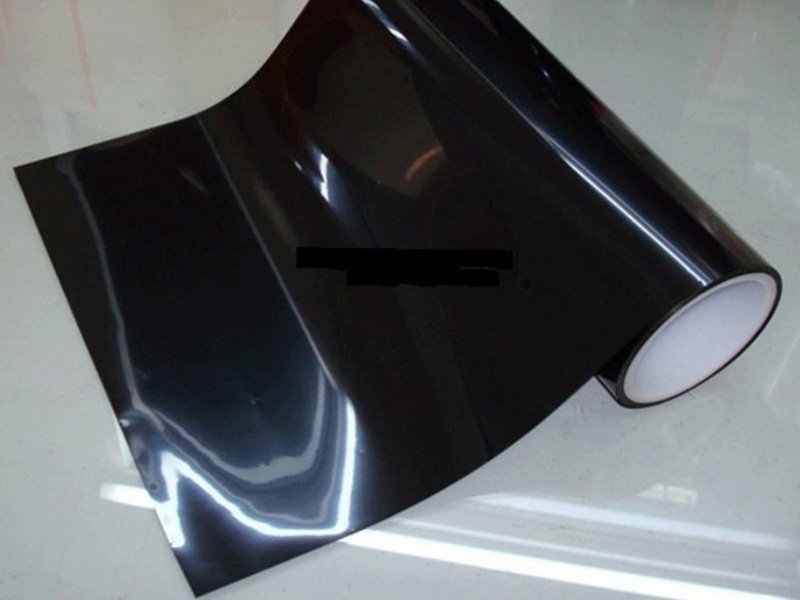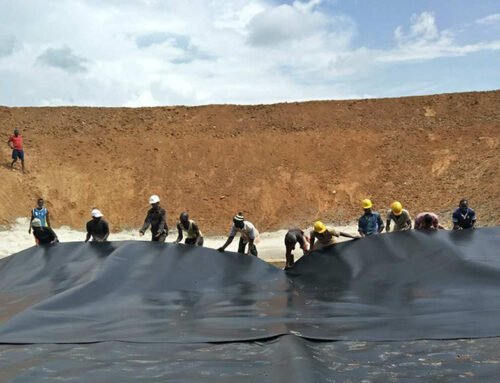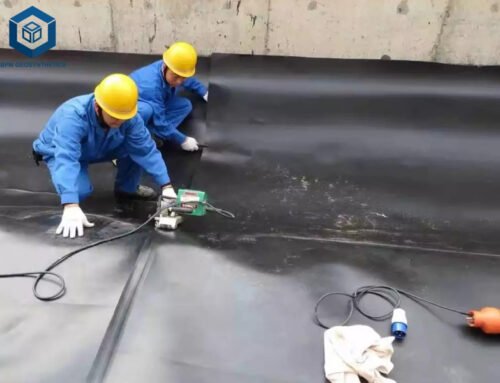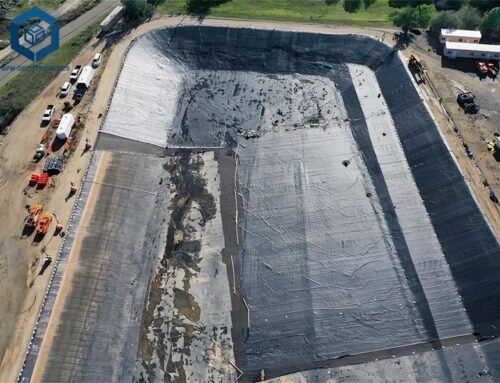HDPE and PVC geomembrane liner are two commonly used anti seepage materials in various civil engineering applications, but each with its own set of characteristics. BPM is the leading geomembrane manufacturer and supplier, we wholesale hdpe geomembrane liner for worldwide customers. In this article, let’s explore the differences between HDPE geomembrane liner and PVC geomembrane liner. We hope it will help you to choose perfect geomembrane liner for you specific projects. BPM Geomembrane is always standing behind you to offer best geomembrane products and services.
1. Definition of Geomembrane Liner
Geomembrane liner is a synthetic membrane or liner material used in civil engineering and environmental engineering, usually made of high molecular polymers, such as polyethylene (PE), polyvinyl chloride (PVC), polypropylene (PP), etc. It has the functions of waterproof, barrier, isolation, reinforcement, etc. Geomembrane liner can be used as the anti seepage material for fish ponds, shrimp ponds, water dam liners, oil gas, biogas, landfill liners, mining, salt, and so on.
2. Definition of HDPE geomembraneLiner and PVC Geomembrane Liner
2.1 What IS A HDPE Geomembrane Liner
HDPE (High-Density Polyethylene) geomembranes are made from a thermoplastic polymer that is strong, durable, and resistant to chemicals, punctures, and UV radiation. HDPE is known for its flexibility and is often used in applications that require high stress resistance, such as in mining and agriculture. HDPE geomembranes are also relatively easy to install and weld together.
2.2 What IS A PVC Geomembrane Liner
PVC (Polyvinyl Chloride) geomembranes, on the other hand, are made from a synthetic plastic polymer that is lightweight, flexible, and has good chemical resistance. PVC geomembranes are often used in applications that require low permeability and excellent weather resistance, such as in water containment. The prices of PVC geomembrane and HDPE geomembrane can vary based on several factors, including the thickness of the material, the size of the geomembrane rolls or sheets, the PVC or HDPE manufacturer, and regional market conditions. Generally, PVC geomembranes are also relatively easy to install and weld together, but they can be more expensive than HDPE.


3. What is The Difference Between HDPE And PVC Geomembrane Liner
HDPE geomembrane liner and PVC geomembrane are two common geomembrane materials, while both materials offer certain advantages, there are notable differences between HDPE and PVC geomembrane liners.
3.1 Difference in Construction
The biggest difference between geomembrane HDPE liner and PVC geomembrane liners is the materials used. HDPE is high-density polyethylene, a thermoplastic polymer based on petroleum, which are welded together for being used for different types of ponds. PVC, on the other hand is polyvinyl chloride, which results in pond liners with smooth surfaces. Unlike HDPE, PVC geomembrane liners are generally glued, and hence, they are not apt for exposure to direct sunlight. Hence, if you live in tropical or hot climates, a HDPE geomembrane liner is the better option for you.
3.2 Different Chemical Corrosion Resistance
HDPE geomembrane liner is superior in chemical corrosion performance and less sensitive to acid, alkali, salt and other chemical substances, so it is suitable for chemical plants, landfills and other environments that require chemical corrosion resistance. However, PVC geomembrane liner has weak resistance to some chemical substances, so special attention should be paid to the use in places where it may be exposed to corrosive substances.
3.3 Different Durability and Strength
Made from high-strength thermoplastic polymers, HDPE pond liners are sturdy and durable, which can stand the test of time for a long period. There are highly resistant to UV, oxidation, chemical reactions, the physical wear and tear. Also, as they are welded and not glued, the chances of leakage and seepage reduces significantly. The organic growth of algae on the surface due to the Habitech technology prevents evaporation and the multi-layer protection from ProTex makes it durable. PVC pond liners, on the other hand, are flexible but less resistant to UV. Prolonged exposure to sunlight causes it to degrade.
3.4 Construction and installation
PVC geomembrane liner is more flexible and easy to bend, can adapt to irregular shapes more easily, and is more convenient for construction and installation. In contrast, HDPE geomembrane is relatively rigid and should be connected with appropriate welding technology, and the construction is more complicated.
3.5 Different Cost
One of the most important factors you need to keep in mind while selecting the geotextile pond liner is the amount of maintenance it would require. Generally, maintenance involves manpower that will involve costs. HDPE geomembrane liner requires little to no maintenance even for a longer period of time, Comparatively, PVC pond liners require much more attention, especially if you’re using them for fish farming. When selecting a geomembrane HDPE, factors such as required performance, engineering project requirements, and budget need to be considered comprehensively.
3.6 Table of Comparision Between HDPE And PVC Geomembrane Liner
HDPE geomembrane liner is a new type of anti-seepage material with the advantages of good physical and mechanical properties, good weldability, no deformation, no expansion and contraction, and long service life. During construction, it has simple operation, stable quality, good anti-seepage effect, and fast construction progress. It eliminates the hidden danger of leakage caused by traditional anti-leakage technology during use. It is widely used in underground spaces, underground buildings, environmental protection, and river management.
Next, let’s take a look at the comparison of the performance of geomembrane HDPE liner and PVC geomembrane liner through a table.
| performance | HDPE | PVC |
| heat resistant | Excellent | generally |
| Antimicrobial | Good | generally |
| Resistant to chemicals | Excellent | Excellent |
| anti-UV | Excellent | generally |
| puncture resistance | good | good |
| Ease of laying | generally | Good |
| cost | medium | low |
| tensile strength | Excellent | High |
| Ozone resistance | No cracks | generally |
| Low temperature resistance without shrinkage C-77C) | Low temperature resistance without shrinkage C-77C) | Hardening and shrinkage in low-temperature climates |


4. Conclusion
Many performance indicators of HDPE geomembrane liner are significantly better than PVC geomembrane liner. Analysis of the reasons: on the one hand, it depends on the different chemical composition and structure of the two; on the other hand, it is also inseparable from the special formula of HDPE geomembrane, such as HDPE The geomembrane contains a certain amount of carbon black, which gives it excellent UV resistance; the HDPE geomembrane contains a certain proportion of antioxidants, so it has good resistance to ozone oxidation and environmental stress cracking. More importantly, the permeability coefficient of HDPE membrane to various liquids is less than 10-13cm/s, while the permeability coefficient of compacted clay rarely reaches 10-7cm/s. It can be seen that the anti-seepage performance of HDPE geomembrane is very superior.
If compacted clay is used as the landfill anti-seepage material, according to China’s “Technical Standard for Sanitary Landfill of Domestic Waste” (CJJ17-89): “The permeability of the clay lining is not greater than 10-7cm/s; If the wall clay lining thickness is greater than 2 m, you must first find a suitable and sufficient soil source, and the soil source area cannot be too far away from the landfill area. Otherwise, the increased transportation distance will increase the construction cost; furthermore, even if the landfill area is The soil permeability in the area is not greater than 10-7cm/s, and it is difficult to ensure that the thickness of the clay lining at the bottom and four walls of the entire landfill area is greater than 2m. In addition, using clay as anti-seepage material also wastes part of the landfill area. Capacity; Moreover, the construction of compacted clay layer on the slope of the landfill area is very difficult.
The use of geomembrane HDPE liner as the anti-seepage layer can completely overcome the above defects. Landfills generally use 1.5 to 2.5mm thick HDPE geomembrane as the lining layer. Compared with the use of 2m thick clay layers, landfill capacity is greatly saved; Setting a protective layer on the HDPE geomembrane can overcome the shortcomings of HDPE geomembrane’s poor puncture resistance. Moreover, the current construction technology of HDPE geomembrane is also very mature and not difficult to master. HDPE geomembrane should be used as the preferred material for the anti-seepage layer of the landfill base, thus providing a reliable guarantee for the landfill to meet the standard requirements of sanitary landfill.
In general, HDPE geomembrane liner is suitable for projects that require higher strength, durability, and chemical corrosion performance, while PVC geomembranes are suitable for applications that require higher flexibility and ease of installation. According to the specific project needs, it is very important to choose the appropriate geomembrane material.





